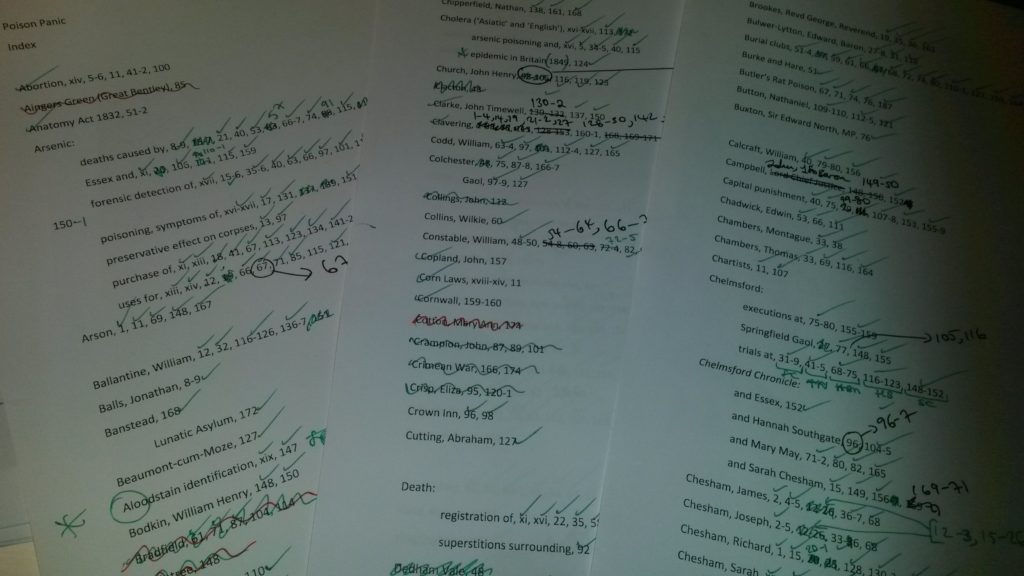
Apart from the obvious difference between fiction and non-fiction – one’s pretend and the other isn’t (more or less) – a non-fiction text should have an index. Indices are awesome, a handy way to zip around a book without having to wade through the entire tome, but have you ever stopped to wonder what compiling an index involves?
This is something I have been wondering since I started work on Poison Panic, for the simple reason that my book would need an index. Gulp.
As a librarian, I must admit that I was actually looking forward to compiling my index. Arranging information in a sensible manner is something I’ve been trained in, and have done on a near-daily basis for years. When I was at “library school” I had cataloguing classes where we had to work out what subjects a book covered and how to choose a classmark for it. If I could do that, then an index would be simple!
Advice and guidelines
First of all, I sought advice. Although there are professional indexers (see the Society of Indexers for information), I didn’t want to farm out my index. The Cambridge University Press has its guidelines for indexing online, so I read through that and thought it looked fairly straightforward. The Society of Authors has lots of guides and articles, one of which (available to members) is on indexing. And Pen & Sword, my publisher, have guidelines on index compilation as well, which they provide for their authors. So how hard could it be?
Pen & Sword’s advice had the nuts-and-bolts, practical advice of marking up the final draft using different coloured highlighter pens (for main mentions and sub-mentions) and then typing up as you go along onto an electronic document. This seemed quite sensible, but I was going from a PDF, so no coloured highlighters for me. As I like working in pen and paper, I went to Ryman’s and bought myself a packet of 100 index cards. I’ve never used these before (apart from cataloguing some East German LP’s donated to the library), and I had only seen my fellow students at university use them for revision (I never did find out how that method worked).

Compiling the index
Once everyone (me, my editor and the designer) were happy with the final draft, so that the pagination wasn’t going to change, the indexing could begin. A PDF arrived in my inbox and the Rocky theme tune played in my head. It was time to get down to business.
I made myself a cup of tea, primed a plate with a chocolate biscuit and a caramel square, split open the packet of index cards and set to work. My publisher’s guidelines said to aim for significant mentions only, and that each page should generate about three index entries each. I ploughed in and realised I’d used ten cards before I’d got to the end of the second page. I was making an entry for everything: it wasn’t so much an index as a list.
I eased off a bit and coasted along quite happily for a while, trying to stick to three entries per page, significant mentions only. But it got complicated when something came up which wasn’t a significant mention, but was significant to the narrative. And also, points that would come up early in the book which would be enlarged on later – there’s a balance here which is rather difficult. I made a note of it on the card anyway… just to be on the safe side. I was descending into panic, worrying that I’d miss something vital.
Part of this worry came from me thinking, “What if someone’s great-great-several-times-grandad is in this book, and they have a walk-on part, and they’ve only bought the book to find out what they did, and they look in the index, and they can’t find them, and then they’ll be really sad!” But then I told myself – they’re in the book anyway! It’s ok! Stop worrying! (I strongly suspect that farming out to an indexer helps as they can take a dispassionate step back from the work which the author has trouble doing).
I had run out of cards by the end of the first chapter, and bought another two packets. This did start to worry me, seeing as Poison Panic has five chapters, and I wondered just how humungous this index would be. I carried on. Some of the cards were good for all the chapters anyway – those for “arsenic” and “Taylor, Alfred Swaine”, for instance – so in the end, I managed to get to the end of the book without needing to buy any more cards. I must’ve used 250 in the end. Blimey.
It was rather frightening to see the vertiginous pile of index cards, which I kept juggling with each time I needed to dig through to note down a mention of “telegraphs” or the barrister Charles Chadwick Jones; I will never know how I didn’t drop the whole lot on the floor. At a couple of points, cards went missing – the one for “burial clubs” ended up somewhere around the M mark. I have no idea how it ended up there. But it meant I had to go through the pile looking for it, which was annoying. Yes, I nearly lost my temper – the desire to scream and fling the entire pile of cards across the room was very hard to resist. It was at this point that the recommendation of typing up as you go along, and not bothering with index cards at all, seemed very sensible.
As well as manually scrolling through the PDF, I made use of the control F function to look for specific mentions – this helped in some instances to tidy things up and also to make sure I could chase something or someone down if I thought I’d missed them off. An advantage over indexing from a print-out.
Typing up
This gave me an opportunity to neaten things up. I’d gone in for thoroughness from the get-go and had some minor people, and subjects with lots of sub-entries. These I did away with as I typed up. As much as using cards seems daft, it did at least give the chance to create a draft index, even if it did make the entire process more long-winded than perhaps it needed to be.
As I typed up, I referred back to the PDF of the book to check on mentions which seemed a bit odd – it was in fact at this point that I created a “Does This Really Need To Be In The Index?” pile. I have a habit of listing things when I write, it’s part of my style, but it causes problems for indexing as it makes for several brief mentions on one page.
This includes Admiral Horatio Nelson – he had earned an index card by virtue of the fact that his great-great-great-great-grandmother is buried in Wix churchyard. It’s the sort of Fascinating Fact that’s worth a brief mention in the book, seeing as quite a lot happens in Poison Panic around the churchyard in Wix, but this is where you have to remind yourself why someone uses an index in the first place. Will someone picking up a book about early Victorian Essex poisoners really think to look up Nelson in the index? No, they will not, because they don’t expect to find him in the book. So out he went. Sorry, Nelson.
At this point, I managed to contracted the index down a little by making some main entries into sub-entries. These were ones which were sort of significant, but not significant enough to earn themselves their own entry, and which I felt someone using the index would look for under another entry anyway. There was a pleasing logic and neatness to this; you can tell I’ve been a librarian for a while, can’t you?

Checking
After wrestling with my printer for an hour – then begging it – then losing my temper and slapping it repeatedly (which did make it work, strangely enough) I printed off the ten-page index. I had been wondering how best to check it, and in the end, the only feasible way I could think of was to go through the index, looking up each page number in the final proof PDF. Yes, this took ages, but I’m glad I did it.
The photo above shows the first three pages of the index. I checked each page for the subject turning up, and it was at this point that I made a final decision as to whether or not it was a significant mention. It was a good point in the process to do it as, once I had a final draft of the index, I had an overview of it. Florence Maybrick and Mary Ann Cotton were turfed out of the index at this stage. I’d included them because I assumed someone picking up a book about arsenic deaths would expect to find them in the index, but they only get a passing mention in Poison Panic. If you saw them in the index, flicked to the page they were on and then saw them flashing by as examples in the sentence “Other women would be accused of poisoning with arsenic”, you’d feel rather short-changed.
The index was a lot of work, and ‘It’s not a pleasant thought neither – is it?’ that I’ll have to do it all over again with Fatal Evidence. But at least when I come to tackle that, I will at least be approaching it with the thought “I’ve done this before, it doesn’t scare me.” Because believe me, compiling this index was terrifying (having a really bad cold didn’t help either). Never having done it before, I was so worried I’d got it horribly wrong. Had I even taken the right approach? I am under no illusions that it’s the world’s most amazing index: there are no doubt entries which are not really significant enough, and for that I apologise, but hopefully I’ve removed the particularly insignificant mentions from it.
Once the final, final draft of the book turned up, the first thing I did was turn to the index. And there it was. And it actually looks like a proper index. When I thought how far it’d come, from scribbles on index cards, I must admit that I was quite pleased with myself. And then I sneezed, and the cards, which were still stacked on the desk in front of me, flew with great velocity in 250 different directions across the room. Oh well. At least I tried.
